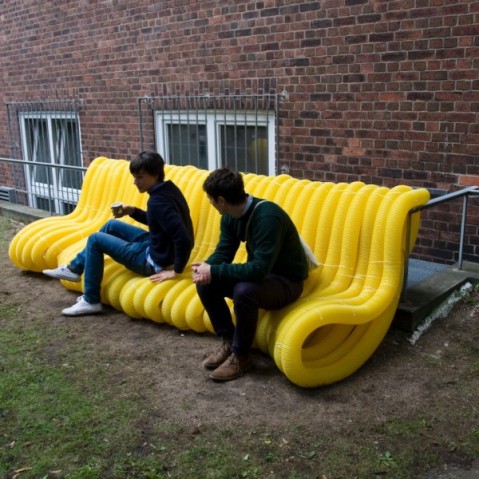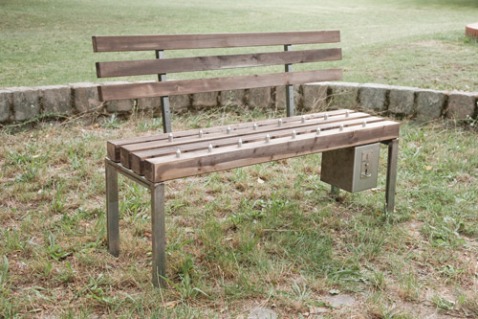Unlikely Seats in Hamburg

Oliver Show’s “Street Furniture” series wraps yellow drainage pipes around public infrastructure in Hamburg, Germany. Photo by Der Spiegel via Architizer
Architect Oliver Show decided to turn some of Hamburg, Germany’s least comfortable spaces into squishy seats, lounges and sofas. Mr. Show wrapped common pieces of urban infrastructure like bridge trusses, hand rails and bike racks with bright yellow plastic drainage pipes turning once angular and unlikely elements into comfortable, low-cost, weather resistant places to sit.
Providing pedestrians an opportunity to sit increases their comfort and desire to linger in a place but I wonder how comfortable these seats are for longer than a few minutes. Would these seats only serve strong and able-bodied users? Is it difficult to climb on top of them and must you balance there? Do the pipes sway back and forth? How tightly together they pipes are bound so users (especially children) don’t fall in the spaces in between?
I look forward to testing them out myself one day!

Oliver Show’s “Street Furniture” series wraps yellow drainage pipes around public infrastructure in Hamburg, Germany. Photo by Der Spiegel via Architizer
Antistress for Free!
An “antistress” art installation appeared on the side of a bus stop in Milan, Italy.
Would You Pay to Sit?
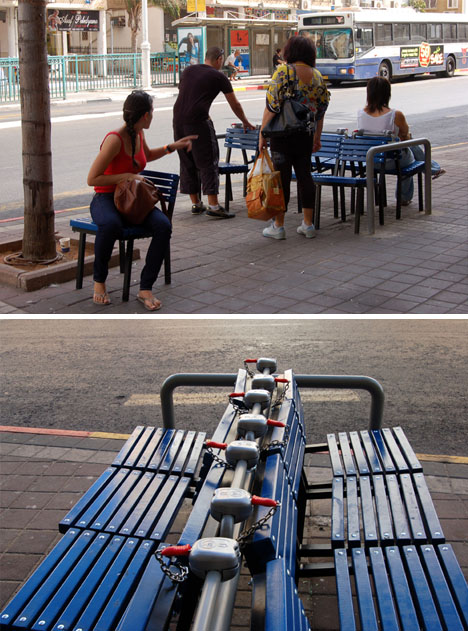
A paid public seating experiment in Bat Yam, Israel by Vincent Wittenberg. Photo by Vincent Wittenberg via Web Urbanist.
One of the reasons a public spaces becomes successful (meaning well-used) is because it is customizable and an important part of being able to customize your space is being able to have many different seating options. Individual, light-weight chairs which are not bolted into the ground, allow you to customize your experience by siting alone, siting in groups, moving in to the shade or moving in to the sun.
Some municipalities and businesses are weary of incorporating these types of chairs in our public spaces because they are understandably afraid these chairs will be stolen. It’s not easy to be secretive about stealing brightly colored chairs in the bustling pedestrian plazas of Manhattan, but for lesser populated areas, stealing street furniture (chairs, tables, umbrellas, trash cans, etc) can be an issue.
Artist Vincent Wittenberg asked the municipality of Bat Yam in Israel if he could research the behavior of individuals who were given the option of paying to sit in a public space and he wondered how many people would pay to customize the space for their own use. Mr. Wittenberg’s work explores the “border points” of public, private and collective spaces and says that he and his researchers “found out that the borders between those spaces are not strict and even flexible. Although ownership of space is important, many residents do cross the border by claiming public or common space for their own private use. This behaviour seems to be peacefully tolerated by the authorities and other residents.”
Mr. Wittenberg proposed that Bat Yam install benches which could also be converted in to individual seats. These seats will only be released once a five Shekel coin has been deposited but once the seat is returned, so is the coin.
Artist Fabian Brunsing tackled similar themes with a piece which criticizes the privatization of our public spaces. His “Pay & Sit” bench installation allows users to pay to sit comfortably on an otherwise spiked bench – but only for a short period of time. Thankfully, a loud warning signal alerts you to the need to get up quickly, before the metal spikes return.
Street furniture being stolen is an important issue but should this issue (and others concerns such as street furniture encouraging negative activity, graffiti, homeless individuals sleeping, etc) deter us from providing furniture at all? Successful public spaces are also those that are comfortable to a diverse audience (with a wide spectrum of physical abilities, those carrying heavy loads, those with children or elderly companions, etc) and therefore they are important to public spaces. These artists explore and exploit our desire for more successful public spaces.
CicLAvia’s Play Street
One of my favorite events in Los Angeles is CicLAVia, a bi-annual event that closes around 10 miles of streets to cars, filling them with bicycles, food trucks and fun. And every year it is equally as amazing to see Los Angeles’ wide boulevards filled with bicycles and pedestrians enjoying the streets and experiencing Los Angeles in an entirely new way.
The origin of CicLAvia is Ciclovía from Bogotá, Colombia. Bogotá has inspired many innovative transportation planning projects here in the US but the idea of Ciclovía or “open street” projects may be most popular. These projects can be truly transformative because they allow anyone to experience what our largest public space could be like if it prioritized people instead of cars. The Open Streets Project has created a comprehensive database of projects in almost every state in the country. From New York to Fargo to San Antonio, residents can enjoy lively open streets filled with the rush of people instead of cars
For October’s CicLAvia, some friends and I from the Living Streets Los Angeles volunteer committee, decided to take over a side street along the CicLAvia route in Los Angeles’ Chinatown and turn it in to a street filled with playful activities. Our inspiration for our play street came from the incredible work of urban planner and artist Candy Chang. Ms. Chang transforms public space through engaging participatory art projects that allow residents to use their imaginations to dream of what spaces can become.
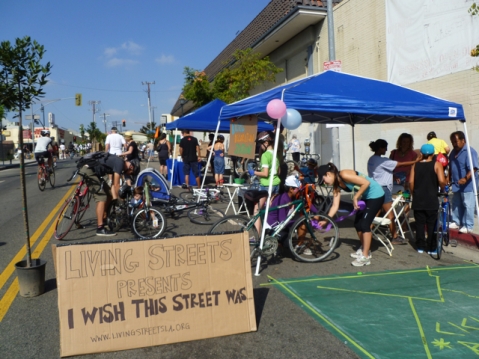
“I Wish This Street Was…” presented by Living Streets Los Angeles at CicLAvia. Photo by Living Streets Los Angeles
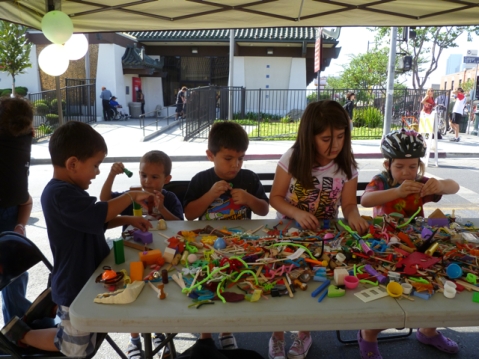
Children design their ideal street at “I Wish This Street Was…” presented by Living Streets Los Angeles at CicLAvia. Photo by Living Streets Los Angeles

Photo booth fun at “I Wish This Street Was…” presented by Living Streets Los Angeles at CicLAvia. Photo by Living Streets Los Angeles

Children painting with their parents for “I Wish This Street Was…” presented by Living Streets Los Angeles at CicLAvia. Photo by Living Streets Los Angeles

Photo booth fun during “I Wish This Street Was…” presented by Living Streets Los Angeles at CicLAvia. Photo by Living Streets Los Angeles

Community members envision a new use for a street in Los Angeles (based on “I Wish This Was…” by Candy Chang). CicLAvia, Los Angeles. Photo by Living Streets Los Angeles.

Community members envision a new use for a street in Los Angeles (based on “I Wish This Was…” by Candy Chang). CicLAvia, Los Angeles. Photo by Living Streets Los Angeles.
Crosswalk Performance Art in Paris
French theater group X/TNT wanted to raise awareness about the dangerous conditions that exist for pedestrians at La Place de L’Etoile (the roundabout under the Arc de Triomphe) in Paris. Check out their performance, creating a temporary street level crossing (the city prefers pedestrians access the Arc via an underground pedestrian tunnel) to get from one side of the street to another.
STRESS FREE – La prise de l’étoile – Pedestrian crosswalk from Xtnt – Urban Theater on Vimeo.


